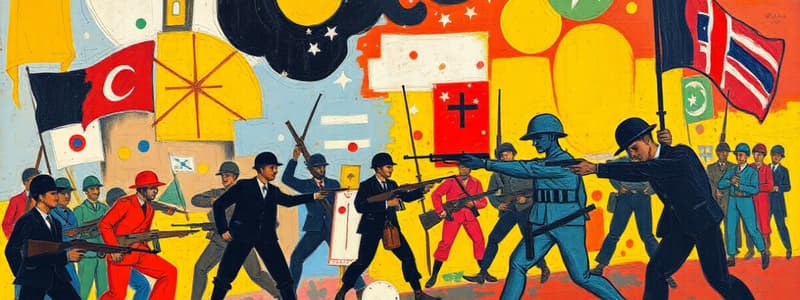Podcast
Questions and Answers
What event is commonly considered to have sparked World War I?
What event is commonly considered to have sparked World War I?
- The sinking of the Lusitania
- The invasion of Belgium
- The signing of the Treaty of Versailles
- The assassination of Archduke Franz Ferdinand (correct)
Which of the following were major battles of World War I?
Which of the following were major battles of World War I?
- Battle of Verdun (correct)
- Battle of Stalingrad
- Battle of Britain
- D-Day (Normandy Invasion)
What was one major outcome of World War II?
What was one major outcome of World War II?
- Establishment of the Axis powers
- Treaty of Brest-Litovsk
- Formation of the League of Nations
- Creation of the United Nations (correct)
Which factor contributed to the outbreak of World War II?
Which factor contributed to the outbreak of World War II?
What was a significant technological advancement during both World Wars?
What was a significant technological advancement during both World Wars?
Which statement is true regarding the social impact after World War II?
Which statement is true regarding the social impact after World War II?
What significant event marked the official start of World War II?
What significant event marked the official start of World War II?
Which of the following best describes a long-term economic impact of World War I?
Which of the following best describes a long-term economic impact of World War I?
Flashcards are hidden until you start studying
Study Notes
World Wars: Key Facts and Concepts
World War I (1914-1918)
-
Causes:
- Militarism: Arms race among European powers.
- Alliances: Complex network of treaties (Triple Alliance vs. Triple Entente).
- Imperialism: Competition for colonies and resources.
- Nationalism: Ethnic tensions and desire for independence.
-
Key Events:
- Assassination of Archduke Franz Ferdinand (1914) sparked the war.
- Major battles: Battle of the Somme, Battle of Verdun, Gallipoli Campaign.
- U.S. Entry (1917): Joined Allies, tipping the balance against Central Powers.
-
Outcome:
- Treaty of Versailles (1919): Harsh penalties on Germany, redrawing of European borders.
- Formation of League of Nations: Aimed at preventing future conflicts.
- Social and economic upheaval worldwide.
World War II (1939-1945)
-
Causes:
- Treaty of Versailles: Resentment in Germany and economic hardship.
- Expansionism: Aggressive moves by Axis Powers (Germany, Italy, Japan).
- Failure of Appeasement: Western powers' initial inaction to Axis aggression.
-
Key Events:
- Invasion of Poland (1939): Official start of the war, leading to Allied declaration against Germany.
- Major battles: Battle of Britain, Stalingrad, D-Day (Normandy Invasion).
- Holocaust: Systematic genocide of six million Jews and millions of others.
-
Outcome:
- Allied victory in 1945: Led to unconditional surrender of Germany and Japan.
- Creation of the United Nations: Aimed to foster international cooperation.
- Division of Europe: Cold War beginnings with Iron Curtain dividing East and West.
Aftermath of Both Wars
-
Social Changes:
- Shifts in gender roles: Women entering the workforce during both wars.
- Rise of the U.S. and the Soviet Union as superpowers post-WWII.
-
Economic Impact:
- WWI: Economic turmoil in Europe, leading to the Great Depression.
- WWII: Marshall Plan initiated to aid European recovery.
-
Technological Advancements:
- Development of military technology: Tanks, aircraft, and eventually nuclear weapons.
-
Geopolitical Changes:
- Redrawing of national borders in Europe and Asia.
- Decolonization movements gaining momentum post-WWII.
World War I (1914-1918)
- Militarism drove an arms race among European nations, escalating tensions.
- Alliances formed a complex network dividing Europe into the Triple Alliance and Triple Entente.
- Imperialism created competition for colonies and resources, heightening conflicts.
- Nationalism fueled ethnic tensions and desires for national independence.
- The assassination of Archduke Franz Ferdinand in 1914 served as the immediate catalyst for the war.
- Major battles included the Battle of the Somme, Battle of Verdun, and the Gallipoli Campaign.
- U.S. entry into the war in 1917 provided crucial support to the Allies, shifting the balance against the Central Powers.
- The Treaty of Versailles in 1919 imposed severe penalties on Germany, including territorial losses and reparations.
- The League of Nations was established to promote peace and prevent future conflicts.
- The war caused significant social and economic upheaval globally, influencing the geopolitical landscape.
World War II (1939-1945)
- The Treaty of Versailles fostered resentment and economic hardship in Germany, contributing to the war's outbreak.
- Expansionist policies of the Axis Powers, including Germany, Italy, and Japan, heightened international tensions.
- Failure of appeasement illustrated Western powers' initial inaction against Axis aggressions, exacerbating the conflict.
- The invasion of Poland in 1939 marked the official start of World War II, prompting Allied declarations of war against Germany.
- Significant battles included the Battle of Britain, Battle of Stalingrad, and D-Day (Normandy Invasion).
- The Holocaust was a horrific genocide that led to the systematic extermination of six million Jews and millions of other victims.
- Allied victory in 1945 resulted in the unconditional surrender of both Germany and Japan.
- The United Nations was formed to encourage international cooperation and prevent future conflicts.
- Europe was divided post-war, leading to the onset of the Cold War characterized by the Iron Curtain dividing East and West.
Aftermath of Both Wars
- Social changes included shifting gender roles, with women entering the workforce during both wars.
- The U.S. and the Soviet Union emerged as superpowers following World War II, reshaping global power dynamics.
- Economic impacts included turmoil in Europe post-WWI contributing to the Great Depression, and post-WWII recovery aided by the Marshall Plan.
- Technological advancements were paramount, leading to developments in military technology, including tanks, aircraft, and nuclear weapons.
- Geopolitical changes involved the redrawing of national borders in Europe and Asia, alongside rising decolonization movements.
Studying That Suits You
Use AI to generate personalized quizzes and flashcards to suit your learning preferences.




